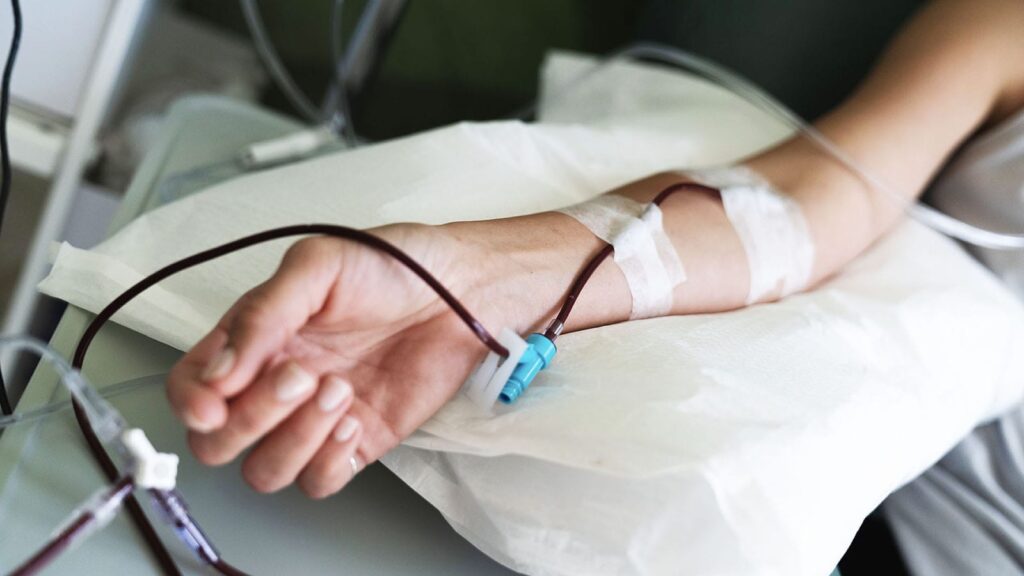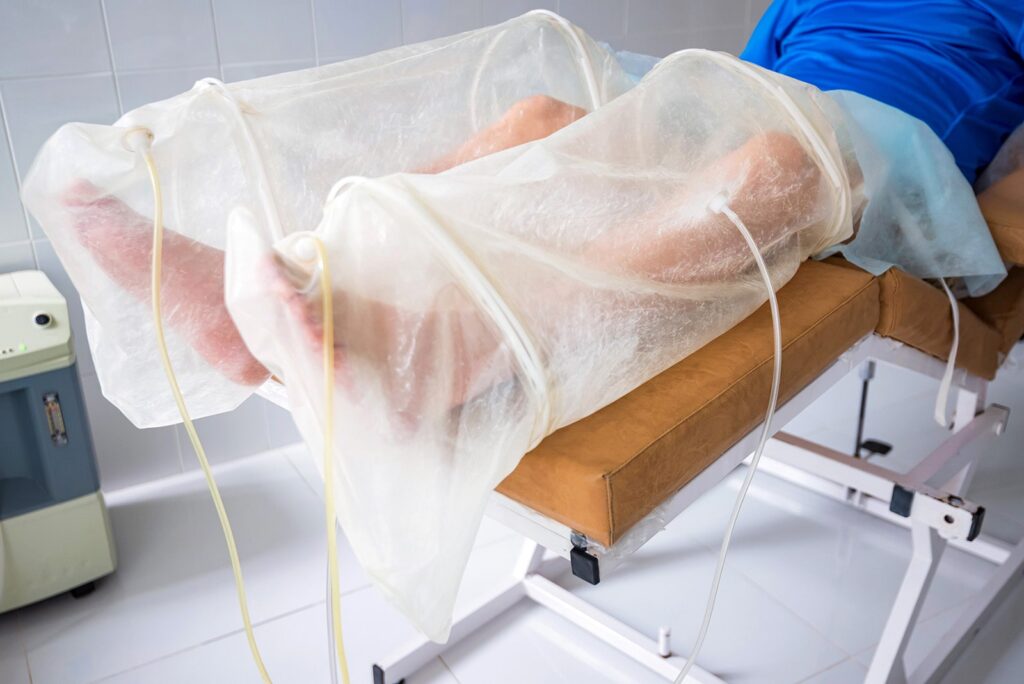Welcome to an explorative journey, one that is often surrounded by both intrigue and skepticism: Ozone Therapy.
Ozone therapy is a controversial alternative medicine practice that involves the use of ozone gas for its proposed therapeutic effects. Despite being a potent oxidant capable of causing damage if misused, under precise therapeutic doses, it has been suggested to impart numerous health benefits.
As someone who has personally undergone ozone therapy for sinus infections, I will share a comprehensive understanding of this controversial treatment method, its uses, benefits, and potential risks while drawing from extensive research as well as my own experience.

What Is Ozone Therapy?
Ozone therapy is a controversial alternative medical treatment that introduces ozone or ozonides to the body [1]. Ozone is a colorless gas made up of three atoms of oxygen (O3) [2]. Medical-grade ozone is created using an ozone generator device [3]. Ozone therapy is used to treat medical conditions and as a topical disinfectant[4].
For those unfamiliar, ozone therapy refers to the administration of ozone gas into the body for therapeutic purposes. Ozone is a colorless gas composed of three oxygen atoms. It’s a naturally occurring molecule that’s critical to life on Earth.
Like mentioned above, in the medical context, ozone therapy involves introducing medical ozone – a precise mix of ozone and oxygen – into the body. This can occur in several ways, including injecting the gas into tissues, introducing it into the bloodstream, or applying it topically to wounds.
The concept behind this therapy is that the introduced ozone will react within the body, aiding in oxygen supply and promoting a healthier cellular detox balance. The notion is that this in turn can support the immune system, aid wound healing, and possibly alleviate a variety of chronic and degenerative diseases. However, the treatment is not without its risks, as ozone is a toxic gas in high concentrations.

Ozone in Disinfecting Drinking Water
Beyond its potential medical applications, ozone is also widely used to disinfect drinking water. Ozone is a powerful oxidant that can kill bacteria, viruses, and other microorganisms quickly and effectively without the use of chemicals. This property has made it a preferred method for treating water in many parts of the world.

My Personal Experience with Ozone Therapy
As someone who has personally undergone ozone therapy treatments, I can speak from firsthand experience about the process. The reason I sought out the treatment was to help address my chronic sinus infections. To say that I was hopeful would be an understatement. I was looking for a solution, and from what I’d heard, ozone therapy seemed like a promising avenue to explore.
That said, I quickly learned that finding the right clinic for ozone therapy was crucial. It was akin to navigating the wild, wild west; not all medical offices are well-versed in the nuances of administering ozone. In fact, it’s vital to find a clinic where the doctors, not just nurses, are present and experienced in ozone therapy.
One of the crucial aspects to understand is the concept of ‘passes’. A pass refers to how many times the ozone gas is circulated in your body in one session. This number is not something to take lightly, too many passes can be dangerous and even deadly. I was recently surprised to learn from a friend that some clinics might give many passes without adequate testing. It’s a sobering reminder that you have to be proactive and cautious in selecting your clinic. Do your research and only go to reputable clinics!

Different Types of Ozone Therapy
There are two main types of ozone therapy that you might come across. The first method, and the older of the two, involves injecting the ozone gas directly into your vein. This method is falling out of favor because of its potential adverse effects- with repeated sessions, your veins can potentially fail.
The second, and arguably safer method, involves a more roundabout route for introducing the ozone into your body. This process involves drawing your blood, mixing it with ozone and saline in a bag, and then running the mixture through an ultraviolet light IV machine. This process purportedly cleans the blood and infuses it with ozone before it is reintroduced into your body. See a video of the process here on my Instagram.
Of course, the specifics of this procedure, like the amount of blood drawn and the amount of ozone used, must be carefully calibrated. For instance, if 8 ounces of blood are drawn, a specific amount of ozone must be added. Similarly, if only 4 ounces are drawn, the ozone amount must be adjusted accordingly.

Uses and Benefits of Ozone Therapy
Ozone is being used as a supportive treatment for allergies, autoimmune diseases, bacterial infections, cancer, chronic fatigue, circulatory and cardiovascular issues, inflammatory conditions, joint pain, Lyme disease, Epstein-Barr Virus (EBV), and a myriad of other serious illnesses – totaling to around 134 different conditions.
Research has shown potential beneficial effects in patients suffering from knee osteoarthritis, chronic wounds, and lumbar disk herniation. There are also studies hinting at clinical improvement in HIV/AIDS patients treated with ozone therapy, as it could contribute to lower viral load levels. It’s believed that ozone therapy may help the body combat bacteria, viruses, and other harmful agents, thus enhancing the immune response behavior.
Another promising application of ozone therapy is in the realm of anti-aging. By potentially reducing chronic oxidative stress and chronic inflammatory diseases, ozone therapy could contribute to the prevention and management of age-related conditions.

Improved Immune System
Ozone can inactivate bacteria, viruses, fungi, yeast, and other pathogens that can weaken the immune system[5]. Ozone therapy can ramp up the body’s antioxidant production, which can help protect against oxidative stress and improve immune function[6].
Medical ozone therapy can potentially influence the immune system in a few different ways. It can stimulate the production of white blood cells, which play a crucial role in our body’s defense against infections and diseases. Ozone may also enhance the production of interferon, a group of signaling proteins that our bodies produce in response to the presence of viruses. Finally, it has been suggested that ozone therapy can stimulate the body’s antioxidant systems, helping to neutralize harmful free radicals that can cause damage to cells.

Breathing Disorders
Breathing disorders, including chronic obstructive pulmonary disease (COPD) and asthma, can be debilitating. Ozone therapy is being researched as a potential treatment for these conditions, thanks to its proposed anti-inflammatory and immunomodulatory effects.
In the context of respiratory diseases, it’s important to note that ozone therapy is typically administered intravenously or as an injection. Breathing in ozone gas directly can be harmful and is not recommended. With any breathing disorder, it’s important to discuss any new treatment, including ozone therapy, with a healthcare provider to ensure it’s safe and appropriate for your specific condition.

Ozone Therapy in Knee Pathology
Ozone therapy has been examined for its potential role in managing knee pathology, including knee osteoarthritis. The therapy, often administered as intra-articular injections in this context, may help alleviate pain and improve mobility.
Some studies have found that ozone injections can reduce pain and improve function in individuals with knee osteoarthritis. It’s thought that ozone might help by reducing inflammation within the joint. However, more research is needed to fully understand the effects of ozone therapy in knee pathology.
Infiltrative Ozone Therapy in Rheumatoid Arthritis
Rheumatoid arthritis is an autoimmune disease that causes chronic inflammation of the joints. It can lead to painful swelling that can eventually result in bone erosion and joint deformity. Some studies suggest that infiltrative ozone therapy, which involves injecting ozone into the affected joints, can help reduce inflammation and pain in individuals with rheumatoid arthritis.
In these cases, the ozone is believed to react with the synovial fluid in the joints, leading to a decrease in inflammatory markers. Despite these promising early results, more extensive clinical trials are needed.

Safety and Risks of Ozone Treatments
While ozone therapy has been claimed to be effective in treating various medical conditions, the U.S. Food and Drug Administration (FDA) regards it as quackery and has not approved it to treat any medical condition [7].
Just as with any medical intervention, in this case it’s important to address the question, “Is ozone therapy safe?” According to a systematic review of clinical trials, when administered correctly, ozone therapy can be safely tolerated by most patients and lead to a significant reduction in the symptoms of some diseases.
However, there is a risk of adverse effects if the therapy is not properly administered, if the patient has certain pre-existing conditions or if your body is exposed to more ozone than it can safely tolerate (ozone can be toxic in high concentrations). Therefore, the administration of ozone must be done in precise therapeutic doses to prevent ozone toxicity.
In my personal experience, I’ve found that undergoing ozone therapy is not a one-and-done deal. It requires multiple sessions, and it’s certainly not cheap. That being said, for people struggling with chronic diseases, the potential benefits might outweigh these challenges.
It’s also worth noting that while ozone therapy can be beneficial for those dealing with chronic illness, it’s not necessarily a treatment everyone should rush to try. For example, if you have minor inflammation or are generally healthy, you likely won’t need this treatment. It’s really about assessing your specific health needs and discussing these with health professionals who can provide guidance based on their knowledge and your medical condition.

The Role of Ozone in Holistic Health
Beyond its direct applications in treating specific conditions, ozone therapy also plays a role in the broader context of holistic health. As an advocate for alternative medicine, I firmly believe in the importance of regular detoxification. Just as we would service a car or deep-clean our homes, it’s equally important to cleanse our bodies from the inside out.
Through my journey, I’ve learned that ozone therapy can play a vital role in this process. By potentially eliminating bad cells and bacteria, ozone therapy is like giving your body a thorough internal cleanse. In my case, it’s been instrumental in addressing my sinus issue.
Remember that ozone therapy is just one tool in the toolbox. It’s not a substitute for a balanced diet, regular exercise, and a healthy lifestyle. It’s also not a replacement for conventional treatments for serious illnesses but can be used in conjunction with them for a comprehensive treatment approach.

The Future of Ozone Therapy
While the potential of ozone therapy in treating medical conditions is promising, more research is needed to fully validate its effectiveness and safety. Current studies are exploring its use in diverse applications, from aiding diabetic patients to managing conditions such as herpes zoster.
In the end, the key is to approach ozone therapy with a critical and informed mind because it does offer another potential tool in the broad spectrum of healthcare options. As research continues, we will hopefully gain a clearer picture of where ozone therapy can be most beneficial and how to best use it.

Coaching Sessions
I am currently offering one-on-one coaching sessions to help individuals who may be facing challenges in achieving their goals independently. My goal as a coach is to guide and support you in every step of your journey, while also holding you accountable for the actions you take towards achieving your desired outcomes.
Whether you want to improve your health and wellness, establish better habits, or achieve personal and professional growth, I can provide you with personalized attention, a customized approach that suits your unique needs, and the necessary tools and motivation to help you reach your full potential and transform your life.

Conclusion
In conclusion, With the growing interest in alternative medicine, ozone therapy continues to be a subject of extensive research and discussion. From aiding in the treatment of chronic diseases, autoimmune disorders, and respiratory diseases to potentially offering preventive therapeutic effects, it seems to hold promise. However, it also brings with it potential risks and requires careful administration by well-trained medical professionals.
As someone who has benefited from ozone therapy, I share these experiences and information not to suggest that this is a cure-all, but rather, to enlighten and encourage further conversation. Ozone therapy, like any medical treatment, should be approached with a comprehensive understanding and a thorough discussion with a trusted healthcare provider. The decision to undergo ozone therapy should be made based on individual health needs, potential benefits, and potential risks.
Remember, your health is your wealth. Take good care of it!
FAQ
Ozone therapy is an alternative medicine practice that involves introducing ozone gas into the body for therapeutic benefits. It can be administered in different ways, including via injections or intravenously.
The two main types of ozone therapy are systemic and local. Systemic therapy includes intravenous administration, while local therapy often involves injections or insufflations. In the newer method, blood is drawn, mixed with ozone, and then reinfused into the body.
Ozone therapy has been used to possibly help with a wide range of conditions, including allergies, autoimmune diseases, bacterial and viral infections, chronic fatigue, cardiovascular issues, joint pain, Lyme disease, and many others.
A 'pass' refers to the circulation of ozone gas in the body during a therapy session. The number of passes a person can safely undergo depends on their individual health and must be determined by a knowledgeable healthcare provider.
Like any medical procedure, ozone therapy carries potential risks and benefits. When administered correctly by trained professionals, it is generally considered safe. However, incorrect dosage or administration can lead to adverse effects, including vein failure or potentially life-threatening reactions.
Some studies suggest ozone therapy may have beneficial effects in treating chronic obstructive pulmonary disease (COPD) by reducing inflammation and improving oxygen supply. However, more clinical trials are needed to confirm these results.
Research suggests that ozone therapy may help modulate the immune system and reduce chronic oxidative stress, potentially providing benefits for those with autoimmune diseases. However, individual responses can vary, and further studies are necessary.
Ozone therapy is believed to stimulate the immune system, promoting a more effective response against pathogens. It might also help to modulate the immune response, potentially beneficial for people with immune disorders.
Some research indicates that ozone therapy may have analgesic and anti-inflammatory effects, making it a potential tool in pain management. It's been used for conditions such as knee osteoarthritis and spinal pain.
Ozone therapy is believed to promote wound healing by improving local circulation and oxygen supply, and reducing bacterial load. However, more robust clinical trials are needed to establish its efficacy.
While more research is needed, some suggest that ozone therapy could potentially serve as a preventive therapy, boosting the immune system and helping the body resist infections and diseases.
Possible side effects can include vein failure with intravenous administration, discomfort at the injection site for local treatments, and in rare cases, severe life-threatening reactions to the ozone gas. Always consult with a knowledgeable healthcare provider to discuss potential risks.
The number of sessions varies depending on the individual's health status and the condition being treated. Regular sessions may be required for chronic conditions.

Resources
2. Ozone Therapy: Usage, Efficacy, and More – Healthline
3. Ozone Therapy: What It Is, Uses and Side Effects – Cleveland Clinic Health Essentials
4. Ozone therapy: Uses, benefits, and side effects – Medical News Today
5. How Ozone Infusions Can Boost Your Immunity and Your Health – Warren J. Bleiweiss, MD PA
6. Ozone Therapy Benefits: How It Can Boost Your Immune System | HealthNews
7. Can Ozone Therapy Be Harmful? Side Effects, Complications – MedicineNet

With a positive approach and a motivation mindset, you will reach your health goals, no matter how hard they may seem at first. Learn more about my one-on-one coaching program here.







